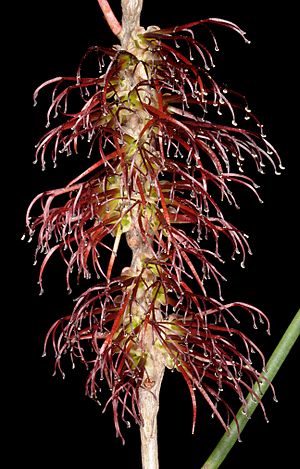Calothamnus lateralis facts for kids
Quick facts for kids Calothamnus lateralis |
|
|---|---|
 |
|
| Scientific classification | |
| Genus: |
Calothamnus
|
| Species: |
lateralis
|
| Synonyms | |
|
|
Calothamnus lateralis is a special plant that belongs to the myrtle family, called Myrtaceae. You can only find it growing naturally in the south-west part of Western Australia. This plant is a small, bushy shrub that spreads out. It has long, round leaves and bright red flowers. What's cool is that the bottom parts of its flowers are hidden inside the plant's rough, cork-like bark.
Contents
What Does Calothamnus lateralis Look Like?
Calothamnus lateralis usually grows to about 1 meter (3 feet) tall. It can spread out to be 1 to 2 meters (3 to 7 feet) wide. Its leaves are long and thin, like a cylinder, usually 70 to 100 millimeters (about 3 to 4 inches) in length.
The flowers are a striking blood-red color. They grow in groups called spikes, which are 40 to 100 millimeters (about 1.5 to 4 inches) long. These flower spikes are found on only one side of the stems. The flowers are partly hidden in the plant's corky bark. This means you can only see the tips of the sepals (small leaf-like parts), the petals (the colorful parts), the stamens (which hold pollen), and the stigma and style (parts of the female flower).
The stamens are grouped together in four narrow, claw-shaped bundles. You can see this plant flowering almost any time of the year. After the flowers, the plant produces woody capsules, which are its fruits.
How Was Calothamnus lateralis Named?
The plant Calothamnus lateralis was first officially described in 1839. This was done by a person named John Lindley. He wrote about it in a book called A Sketch of the Vegetation of the Swan River Colony.
The second part of its name, lateralis, comes from a Latin word. It means "lateral" or "belonging to the side." This name was chosen because the flowers grow only on one side of the plant's stem.
Where Does Calothamnus lateralis Grow?
You can find Calothamnus lateralis in the south-west of Western Australia. It grows from the city of Perth all the way down the coast to Albany and the Stirling Range.
It likes to grow in areas with peaty sand or clay. You'll often find it in swamps or places that get flooded during the winter months. These areas are part of specific natural regions like the Jarrah Forest, Swan Coastal Plain, and Warren.
Is Calothamnus lateralis Protected?
The Western Australian Government's Department of Parks and Wildlife has looked at Calothamnus lateralis. They have decided that it is "not threatened." This means the plant is not currently in danger of disappearing.


